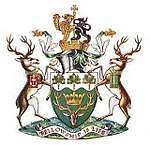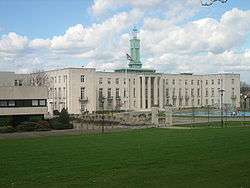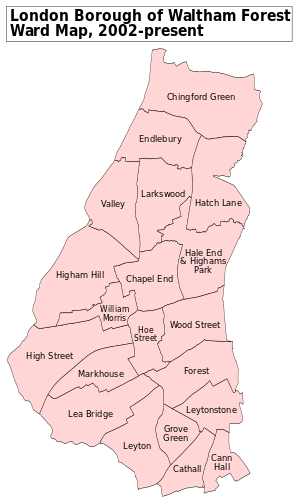Waltham Forest London Borough Council
Waltham Forest London Borough Council is the local authority for the London Borough of Waltham Forest in London, England which has existed since the London Government Act 1963 was commenced in 1965, replacing three local authorities: Chingford Borough Council, Leyton Borough Council and Walthamstow Borough Council. It is one of London's 32 borough councils, divided into 20 wards and elects 60 councillors.
Waltham Forest London Borough Council | |
|---|---|
 Coat of Arms | |
 Council logo | |
| Type | |
| Type | London Borough Council of the London Borough of Waltham Forest |
| History | |
| Founded | 01 April 1965 |
| Preceded by | Chingford Borough Council Leyton Borough Council Walthamstow Borough Council |
| Leadership | |
Mayor of Waltham Forest | |
Leader of the Council | |
Chief executive | Martin Esom since October 2010 |
| Structure | |
| Seats | 60 councillors |
 | |
Political groups | Administration (46)
Opposition (14)
|
| Elections | |
| First past the post | |
First election | 7 May 1964 |
Last election | 3 May 2018[1] |
Next election | 5 May 2022 |
| Motto | |
| "Fellowship is Life" [2] | |
| Meeting place | |
 | |
| Waltham Forest Town Hall, Forest Road, Walthamstow, London E17 4SU | |
| Website | |
| www | |
| Constitution | |
| Constitution | |
History

There have previously been a number of local authorities responsible for the area. The current local authority was first elected in 1964, a year before formally coming into its powers and prior to the creation of the London Borough of Waltham Forest on 1 April 1965. Waltham Forest replaced Chingford Borough Council, Leyton Borough Council and Walthamstow Borough Council.[3]
It was envisaged through the London Government Act 1963 that Waltham Forest as a London local authority would share power with the Greater London Council. The split of powers and functions meant that the Greater London Council was responsible for "wide area" services such as fire, ambulance, flood prevention, and refuse disposal; with the local authorities responsible for "personal" services such as social care, libraries, cemeteries and refuse collection. As an outer London borough council it has been an education authority since 1965. This arrangement lasted until 1986 when Waltham Forest London Borough Council gained responsibility for some services that had been provided by the Greater London Council, such as waste disposal. Since 2000 the Greater London Authority has taken some responsibility for highways and planning control from the council, but within the English local government system the council remains a "most purpose" authority in terms of the available range of powers and functions.[4]
Powers and functions
The local authority derives its powers and functions from the London Government Act 1963 and subsequent legislation. Waltham Forest has the powers and functions of a London borough council. It is a billing authority collecting Council Tax and business rates, it processes local planning applications, it is responsible for housing, waste collection and environmental health. It is a local education authority, responsible for social services, libraries and waste disposal. The council shares responsibility with the Greater London Authority for strategic policies including housing, planning and the environment.[5]
Finances
Waltham Forest London Borough Council is the billing authority for Council Tax, and collects a precepts on behalf of the Mayor's Office for Policing and Crime, the London Fire and Emergency Planning Authority the Greater London Authority and Transport for London.[6]
Political control
Since the first election to the council in 1964 political control of the council has been held by the following parties:
| Party in control | Years |
|---|---|
| Labour | 1964 - 1968 |
| Conservative | 1968 - 1971 |
| Labour | 1971 - 1994 |
| No overall control | 1994 - 1998 |
| Labour | 1998 - 2002 |
| No overall control | 2002 - 2010 |
| Labour | 2010–present |
Summary results of elections
Summary of the council composition after each council election, click on the year for full details of each election.
| Year | Labour | Conservative | Liberal Democrats | Independent | Notes |
|---|---|---|---|---|---|
| 1964 | 33 | 3 | 0 | 9 | |
| 1968 | 4 | 44 | 0 | 0 | |
| 1971 | 39 | 9 | 0 | 0 | |
| 1974 | 36 | 12 | 0 | 0 | |
| 1978 | 36 | 21 | 0 | 0 | Boundary changes increased the number of seats by 11.[7] |
| 1982 | 26 | 25 | 6 | 0 | |
| 1986 | 31 | 16 | 10 | 0 | |
| 1990 | 30 | 16 | 11 | 0 | |
| 1994 | 27 | 16 | 14 | 0 | Boundary changes took place but the number of seats remained the same.[n 1][n 2] |
| 1998 | 30 | 15 | 12 | 0 | Boundary changes took place but the number of seats remained the same.[n 3] |
| 2002 | 29 | 18 | 13 | 0 | Boundary changes increased the number of seats by 3.[8] |
| 2006 | 26 | 15 | 19 | 0 | |
| 2010 | 36 | 18 | 6 | 0 | |
| 2014 | 44 | 16 | 0 | 0 | |
| 2018 | 46 | 14 | 0 | 0 | |
By-elections occur when seats become vacant between council elections. Below is a summary of recent by-elections.
| By-election | Date | Incumbent party | Winning party | ||
|---|---|---|---|---|---|
| Leytonstone | 15 October 1992 | Labour | Labour | ||
| Wood Street | 1 May 1997 | Liberal Democrats | Labour | ||
| Leytonstone | 1 October 1998 | Labour | Labour | ||
| Forest | 15 May 2003 | Labour | Liberal Democrats | ||
| William Morris | 4 September 2003 | Labour | Liberal Democrats | ||
| Valley | 28 October 2004 | Conservative | Conservative | ||
| Hoe Street | 18 November 2004 | Labour | Labour | ||
| Leytonstone | 14 July 2005 | Labour | Labour | ||
| Chingford Green | 26 April 2007 | Conservative | Conservative | ||
| Leyton | 14 February 2008 | Labour | Liberal Democrats | ||
| Forest | 5 June 2008 | Liberal Democrats | Liberal Democrats | ||
| Valley | 6 November 2008 | Conservative | Conservative | ||
| Hale End & Highams Park | 4 December 2008 | Liberal Democrats | Liberal Democrats | ||
| Larkswood | 19 March 2009 | Conservative | Conservative | ||
| Larkswood | 12 July 2012 | Conservative | Conservative | ||
| William Morris | 29 June 2017 | Labour | Labour | ||
Notes
- The Essex and Greater London (County and London Borough Boundaries) Order 1993
- The East London Boroughs (London Borough Boundaries) (No. 2) Order 1993
- The Redbridge and Waltham Forest (London Borough Boundaries) Order 1993
References
- "Election Results". Waltham Forest London Borough Council.
- "Civic Heraldry Of England And Wales - Greater London Region". Civicheraldry.co.uk. Retrieved 2020-04-12.
- Youngs, Frederic (1979). Guide to the Local Administrative Units of England. I: Southern England. London: Royal Historical Society. ISBN 0-901050-67-9.
- Leach, Steve (1998). Local Government Reorganisation: The Review and its Aftermath. Routledge. p. 107. ISBN 978-0714648590.
- "Local Plan Responses – within and outside London". Mayor of London. Retrieved 9 April 2020.
- "Council Tax and Business Rates Billing Authorities". Council Tax Rates. Retrieved 8 April 2020.
- "London Borough Council Elections 4 May 1978" (PDF). London Datastore. Greater London Council. Retrieved 25 February 2015.
- "London Borough Council Elections 2 May 2002" (PDF). London Datastore. Greater London Authority. Retrieved 25 February 2015.